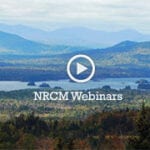By Susan Sharon
MPBN news story
CASCO, Maine — Global climate change, as manifest through extreme weather patterns, is forcing land trusts and conservation agencies to take stock of the special places around them.
That means identifying unfragmented, unique landscapes that support a diversity of plants and animals and could support them in the future. These are places that are likely to be the most resilient to warming temperatures.
The effort to protect this land will require funding. It’s a tall order. But it is already being done in one project in the Sebago Lake watershed.
Most beachgoers at Sebago Lake State Park in Casco probably don’t think about the fact that this lake, which encompasses 45 square miles and runs more than 300 feet deep at its deepest point, is the primary water supply for about 200,000 people in nearly a dozen communities in southern Maine.
And, says Paul Hunt of the Portland Water District, when they go to the tap and fill up their water bottles, like he says he does every day, they probably don’t realize that about 40 percent of the surface water coming into the lake comes down the Crooked River.
It’s a shaded, meandering, clear, cold river, nearly 60 miles long, and it has been identified as one of the state’s “most significant.”
“The reason this lake is so clean is because more than 80 percent of the land that surrounds it and drains into it is forested, and so we recognize that we are benefiting from those forests every day,” Hunt says. “They are treating the water for us.”
He says that’s why this year, the board of the Portland Water District voted to contribute nearly $270,000 to the Crooked River Forest conservation project, the largest contribution it has ever made for this purpose.
“The land can never be developed, so it’s going to be doing the treatment for us in perpetuity, and our board recognizes that that has value to us,” he says.
The 800-acre forest project includes five separate parcels that abut the Crooked River. And while that’s not a lot of acreage as conservation projects go, Lee Dassler of the Western Foothills Land Trust says this one is strategically important for several reasons, including coldwater fish.
“It has landlocked salmon and trout in it, among other species, and is very sought after in terms of fishing qualities,” she says. “And it has very little public access. So now we will have quite a bit more public access. These lands will be open to the public. There will be trails. There will be access guaranteed.”
This river, which starts near Bethel, is part of an area that is ecologically significant for other reasons, too. An analysis by the Nature Conservancy has identified it as one of several places in the northeast that could be climate resilient.
Senior scientist Joshua Royte says that’s because it has a variety of land formations such as north- and south-facing slopes, cliffs, valleys and wetlands. It has relatively unfragmented forest — no highways and not much development — it connects to other protected areas and it has different types of soil. Royte says those criteria are what set it apart.
“This land is very well drained and yet there’s water not too far under the surface that is sort of this glacial-fed aquifer,” he says. “And whatever happens with climate change, vegetation change in the future, this part of the landscape will be different. So that’s why we knew this was important and that really extends to the whole watershed.”
As temperatures warm, streams and tributaries will warm up, too. So will the surface of Sebago Lake. And with increased rainfall, Royte says streams will become more laden with sediment and other debris.
Walking near the Crooked River in Otisfield recently, Jennifer Melville of the Open Space Institute says that’s another reason conservation groups have their eyes on protecting unfragmented forest.
Trees, she says, help keep erosion down and water cleaner and cooler. They will become more important in the face of climate change. And so will protecting climate resilient landscapes such as this one.
“We know things are going to change,” Melville says. “Plants and animals are going to have to figure out how to adapt. Some of them are going to be better off than others. We know that they’re not all going to hold hands and walk north. We have to really plan, think ahead, use good science and protect those resilient places.”
Two local land trusts worked for four years to complete the Crooked River conservation project, which came with a price tag of $1.4 million. They got help from Open Space Institute, the Portland Water District and the Nature Conservancy, along with a $400,000 commitment from the Land for Maine’s Future program.
But Melville says just as the deal was about to close, Gov. Paul LePage announced that he was withholding LMF funding.
“We all came to the table except the state,” Melville says. “The state reneged on its commitment. The land trust had to take out loans and everybody’s scrambling to figure out how to pay back those loans. In the short run we’ll figure it out but in the long run there will be costs.”
Hunt says residents of southern Maine are fortunate to be blessed with an abundant, clean water supply, especially given the fact that less than ten percent of the Sebago Lake watershed is protected from development. The rest is in private hands.
It’s not unusual, Hunt says, for other public water supplies to be at least 60 percent protected. And while buying and conserving land can be expensive, Hunt says the price of doing nothing could prove even more costly if something changes to affect the lake’s water quality.








